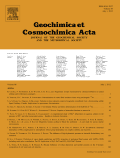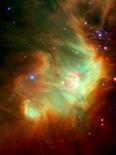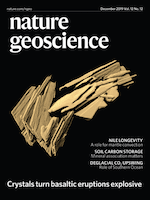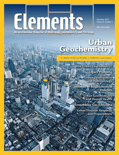
EARTH AND PLANETARY SCIENCE LETTERS
Scope & Guideline
Pioneering Research in Earth and Planetary Sciences
Introduction
Aims and Scopes
- Earth and Planetary Processes:
The journal emphasizes research that elucidates the processes governing the evolution of Earth and other planetary bodies, including tectonics, volcanism, and sedimentation. - Geochemical and Isotopic Studies:
There is a strong focus on the application of geochemistry and isotopic analyses to investigate planetary formation, evolution, and interactions between geological processes and biological systems. - Climate and Environmental Change:
Research exploring the impacts of climate change on geological and environmental processes, including sediment transport, erosion, and biogeochemical cycles, is a core theme. - Geophysical Investigations:
The journal publishes studies employing geophysical techniques to probe the internal structure and dynamics of Earth and planetary bodies, including seismic imaging and tomographic studies. - Interdisciplinary Approaches:
Encouraging interdisciplinary research that integrates geology, geophysics, geochemistry, and environmental science to address complex Earth and planetary problems.
Trending and Emerging
- Climate Impact Studies:
Research examining the impacts of climate change on geological processes, including erosion, sediment transport, and hydrological cycles, is increasingly prominent. - Planetary Science and Astrobiology:
There is a growing trend towards studies related to planetary science, particularly concerning the geological and atmospheric evolution of Mars and other celestial bodies. - Geochemical Cycling and Environmental Change:
Emerging research focuses on the geochemical cycling of elements and its implications for environmental change, including the interactions between biosphere and geosphere. - Advanced Analytical Techniques:
The use of cutting-edge techniques such as machine learning, high-resolution isotopic analysis, and remote sensing is on the rise, facilitating new insights into geological processes. - Geohazards and Natural Disasters:
An increase in studies related to geohazards, including earthquake dynamics, volcanic eruptions, and their societal impacts, is evident, reflecting heightened societal concerns.
Declining or Waning
- Traditional Geology Studies:
There seems to be a gradual decline in papers focused solely on traditional geological mapping and stratigraphy, as the field shifts towards more integrative and quantitative approaches. - Paleoecological Research:
Research centered on paleoecology and biostratigraphy has decreased, possibly overshadowed by more dynamic studies focusing on current climate impacts and geochemical cycles. - Regional Studies:
Specific regional studies that do not apply broader geophysical or geochemical frameworks appear to be less frequent, indicating a trend towards more global or systemic approaches.
Similar Journals

Earth and Space Science
Leading the Way in Earth and Space Research.Earth and Space Science, published by the American Geophysical Union, is a distinguished open-access journal that has profoundly impacted the realms of earth and planetary sciences as well as environmental science since its inception in 2014. With impressive rankings, including Q1 in both Earth and Planetary Sciences and Environmental Science for 2023, this journal ranks 38th out of 195 in the general Earth and planetary sciences category and 51st out of 219 in environmental science, showcasing its commitment to high-quality research dissemination. The journal serves as a vital platform for researchers, professionals, and students, fostering the exploration of critical topics and advancements within these pivotal fields. With an accessible format, researchers can benefit from the rich content available, furthering their knowledge and ensuring that groundbreaking discoveries reach a broader audience. The journal's ongoing commitment to open access aligns with contemporary trends in scholarly communication, emphasizing inclusion and collaboration in tackling pressing global challenges.

GEOCHIMICA ET COSMOCHIMICA ACTA
Advancing Geochemical Insights for a Sustainable FutureGEOCHIMICA ET COSMOCHIMICA ACTA is a premier journal dedicated to advancing the fields of geochemistry and petrology, published by Pergamon-Elsevier Science Ltd. With its ISSN 0016-7037 and E-ISSN 1872-9533, this esteemed journal has been at the forefront of scientific inquiry since its inception in 1950, with a strong commitment to disseminating high-quality research through 2024. Its reputation is underscored by an impressive impact factor and a ranking of #8 out of 154 in Earth and Planetary Sciences according to Scopus, placing it in the 95th percentile of its category. GEOCHIMICA ET COSMOCHIMICA ACTA serves as a critical resource for researchers, professionals, and students alike, offering insights into the complex interactions of geological and cosmological processes. While the journal is not open access, it remains a vital conduit for innovative research, fostering the scientific community’s understanding of earth materials and their significance.

GEOLOGICAL QUARTERLY
Unveiling Planetary Insights Through Rigorous Research.GEOLOGICAL QUARTERLY, published by the Polish Geological Institute, is a respected journal in the field of geology, offering insights into Earth and planetary sciences since its inception in 2000. With an ISSN of 1641-7291 and an E-ISSN of 2082-5099, this journal serves as a vital platform for researchers, professionals, and students seeking to expand their knowledge in geological disciplines. The journal is positioned in Q3 within the geology category as of 2023 and ranks #172 out of 321 in Scopus, placing it in the 46th percentile among its peers. Although currently not an open-access publication, GEOLOGICAL QUARTERLY reflects the policy of fostering scientific communication and collaboration by disseminating valuable geological research. Its commitment to publishing original articles, reviews, and technical notes ensures that it plays a significant role in advancing geological science and its applications within the academic community. With its base in Warsaw, Poland, the journal stands as an important resource for anyone engaged in or studying the Earth sciences.

Boletin de Geologia
Unveiling Colombia's Geological Treasures for the World.Boletin de Geologia is a prominent open-access journal published by UNIV INDUSTRIAL SANTANDER, dedicated to advancing the field of Earth and Planetary Sciences. Since its transition to open access in 2000, this journal has provided a platform for researchers to disseminate their findings and engage with the global scientific community. With an ISSN of 0120-0283 and an E-ISSN of 2145-8553, it is indexed in Scopus and has secured a notable Q3 ranking in the category of miscellaneous Earth and Planetary Sciences as of 2023, reflecting the impact and relevance of its published articles. The journal's geographical scope, rooted in Colombia, allows it to highlight significant geological research pertinent to the region while also contributing to global discussions. Scholars and practitioners interested in innovative research within this field will find Boletin de Geologia an invaluable resource for unlocking knowledge and fostering collaboration in the geological sciences.

Annual Review of Earth and Planetary Sciences
Exploring the Frontiers of Earth and BeyondAnnual Review of Earth and Planetary Sciences is a leading scholarly journal published by Annual Reviews, dedicated to advancing our understanding of the dynamic processes governing the Earth and its celestial companions. With ISSN 0084-6597 and E-ISSN 1545-4495, this esteemed journal, established in 1976, has consistently provided comprehensive reviews that synthesize cutting-edge research across various disciplines, including astronomy, astrobiology, geology, and planetary science. Notably, the journal has achieved a remarkable position in the academic landscape, ranking in the Q1 quartile across multiple categories, including Astronomy and Astrophysics and Earth and Planetary Sciences, with Scopus rankings placing it at the forefront of these fields. The journal's commitment to facilitating open access to critical scientific advances, though not fully open, allows for maximum reach within the research community. Researchers, professionals, and students alike can benefit from the high-impact articles designed to foster collaboration and innovation within the fields of earth and planetary science.

JOURNAL OF IBERIAN GEOLOGY
Unveiling the intricate layers of Iberian geological phenomena.JOURNAL OF IBERIAN GEOLOGY, published by Springer International Publishing AG, is a pivotal platform dedicated to advancing the field of geology and stratigraphy. With an ISSN of 1698-6180 and E-ISSN of 1886-7995, this journal has earned its reputation in the academic community, holding a commendable Q2 ranking in both Geology and Stratigraphy for 2023, reflecting its contributions to contemporary geological research. Spanning from 2007 to 2024, it provides a comprehensive forum for scholars and practitioners from around the globe to disseminate their findings pertaining to the Iberian Peninsula, enhancing the understanding of regional geological phenomena. The journal has carved out a significant niche within the Earth and Planetary Sciences, ranking #137 out of 321 in Geology and #24 out of 55 in Stratigraphy, indicating its wide-reaching impact and scholarly engagement. The Journal of Iberian Geology serves as an indispensable resource for those interested in the complexities of geological structures, stratigraphic sequences, and the broader implications of geological research, making it a vital reference for researchers, professionals, and students alike.

Journal of Advances in Modeling Earth Systems
Exploring Innovative Models for a Sustainable Planet.Journal of Advances in Modeling Earth Systems, published by the American Geophysical Union, is a foremost open access journal that has been contributing to the fields of Earth and Planetary Sciences, Environmental Chemistry, and Global and Planetary Change since its inception in 2009. With a remarkable impact factor and consistently maintained Q1 category rankings across several key disciplines, this journal stands out as a leading platform for disseminating innovative research and modeling advancements critical to understanding Earth systems. It is ranked in the top 5% of Earth and Planetary Sciences and Environmental Chemistry, emphasizing the high caliber of work published within its pages. The journal engages a diverse audience, including researchers, professionals, and students, by providing a comprehensive repository of cutting-edge studies and findings that are openly accessible to the global scientific community. With its headquarters in the United States and converging research from 2011 to 2024, the Journal of Advances in Modeling Earth Systems remains an essential resource for those seeking to explore and advance the frontiers of environmental science and modeling techniques.

Nature Geoscience
Leading the Charge in Geoscientific Discovery.Nature Geoscience, a premier journal published by NATURE PORTFOLIO, provides a platform for the dissemination of high-quality research in Earth and Planetary Sciences. With an impressive impact factor reflecting its significance — ranking in the 99th percentile and positioned at #1 out of 195 in Scopus Ranks within its category, this journal is a leading authority in its field. Since its inception in 2008, it has fostered interdisciplinary collaboration, addressing critical challenges such as climate change, natural disasters, and resource management. Although it does not offer Open Access, the journal is accessible through various research libraries, ensuring that vital findings reach a broad audience. The journal's esteemed reputation in the Q1 quartile of Earth and Planetary Sciences makes it an essential resource for researchers, professionals, and students aiming to advance their understanding of geoscientific phenomena.

Elements
Unveiling the Mysteries of Our PlanetElements is a premier academic journal published by the Mineralogical Society of America, dedicated to advancing knowledge in the fields of Earth and Planetary Sciences and Geochemistry and Petrology. Since its inception in 1973, this journal has established itself as a leading source of impactful research, evidenced by its prestigious Q1 rankings in both categories in 2023, placing it among the top journals globally with Scopus ranks of #18 and #23, respectively. Elements is uniquely positioned to foster interdisciplinary dialogue, offering a platform for groundbreaking studies that explore the fundamental processes shaping our planet. Although it operates without an open access model, its rigorous peer review process guarantees the integrity and quality of published work, making it an essential resource for researchers, professionals, and students eager to stay abreast of the latest developments in mineralogy and earth sciences. With a commitment to excellence, Elements continues to push the boundaries of our understanding of geological phenomena and their implications for both science and society.

JOURNAL OF GEOPHYSICAL RESEARCH-SOLID EARTH
Elevating Scientific Discourse in Solid Earth ResearchJOURNAL OF GEOPHYSICAL RESEARCH-SOLID EARTH is a prestigious journal published by the American Geophysical Union, dedicated to advancing the study of solid Earth sciences. With an ISSN of 2169-9313 and E-ISSN of 2169-9356, it serves as a leading platform for rigorous research findings and innovative advancements within the fields of Earth and Planetary Sciences, Geochemistry and Petrology, Geophysics, and Space and Planetary Science. The journal has achieved an impressive Q1 quartile ranking across these categories, reflecting its high impact in the academic community and underscoring its role in influencing scientific discourse. Notably, it holds an esteemed position in Scopus, ranking 15th among 159 journals in Earth and Planetary Sciences (miscellaneous) as well as within the top 20 in several other geophysical domains. Researchers and practitioners are encouraged to contribute their work to this esteemed journal, which publishes comprehensive articles from 1979 to the present, thus providing a crucial repository of knowledge for those engaged in solid Earth research. Although it does not currently offer Open Access options, the journal's prestigious reputation ensures its articles reach a wide audience of academics, professionals, and students alike, fueling a deeper understanding of our planet's processes and challenges.